Optimal Dispatch of Multi-Type CHP Units Integrated with Flexibility Renovations for Renewable Energy Accommodation
Abstract
:1. Introduction
1.1. Research Background
1.2. Literature Reviews
1.3. Novelty and Contributions
2. Methodology
2.1. Thermodynamic Modelling
2.2. Data-Mining Analysis for the Heat–Power Coupling Mechanism
2.2.1. Steady State Identification
2.2.2. Prediction of Heat–Power Coupling Mechanism Based on Gaussian Process
2.2.3. Work Condition Division
2.3. Optimal Load Dispatch Model
2.3.1. Objective
2.3.2. Constraints
- (1)
- The CHP system including multi-units needs to meet the demand of heating in the heating season. The total heat load of multi-CHP units is equal to the sum of the units’ heat load.where is the heat demand, MW; is the heating extraction steam enthalpy of the No. i unit, kJ/kg; is the drainage water enthalpy of the No. i unit, kJ/kg; n is the unit number of the CHP system in operation.
- (2)
- Due to the design and manufacture of each unit, there are different heating restrictions for each unit, and there is a maximum amount of heating extraction.where is the maximum heat load of the No. i unit, MW.
- (3)
- The operation region constraint is considered as well. The research subject is the CHP system consisting of multi-type CHP units. Therefore, for guaranteeing that there is an operating point of the CHP system, the operating points of various CHP units are required to be within their operation regions. The operation region constraints for various types of CHP units can be expressed simply as follows. For EC units, the power load has an adjustable region when the heat load is given because the heating extraction flow can be regulated. For HBP units and LZPO units, the power load is uniquely determined once the heat load is designated.
2.3.3. Solving Method
2.4. Standard Solution Procedure
3. Case Study
4. Results and Discussion
4.1. Operation Region
4.2. Optimization Results and Multi-Type Units Load Dispatch Strategy
4.3. Impact of Unit Renovations on Load Dispatch
5. Conclusions
- (1)
- The heat–power coupling mechanism of the EC, HBP renovation and LZPO renovation units in the CHP system are analyzed through the data-mining-based analysis method. The LZPO and HBP renovations have the similar impact on the heating supply capacity and reducing the power load. Specifically, the LZPO renovation is more effective than the HBP renovation in reducing the lowest limit of the power load for the CHP system, and then the HBP renovation is more effective than the LZPO renovation in improving the heating supply capacity.
- (2)
- The EC unit has a critical heat load due to the exhaust steam limit of the LPT. With the critical heat load as the dividing point, the trend in the lower limit of the power load for EC units is when the heat load decreases and then increases. The exhaust steam limit of the LPT has the important influence on the heat load dispatch for EC units.
- (3)
- After the optimal load dispatch, the power load of the CHP system can be reduced by 18.7% to 41.7% in the heating season, compared with the actual power load. Because of the different heat–power coupling mechanisms of units, the HBP renovation unit undertakes a steady lower heat load, while both the LZPO renovation unit and EC unit undertake the higher heat load. For reducing the power load of the EC unit, its heat load should be dispatched so that the heat load is as close to its critical heat load as possible.
Author Contributions
Funding
Data Availability Statement
Conflicts of Interest
References
- Takeshita, T.; Aki, H.; Kawajiri, K.; Ishida, M. Assessment of utilization of combined heat and power systems to provide grid flexibility alongside variable renewable energy systems. Energy 2020, 214, 118951. [Google Scholar] [CrossRef]
- Tang, H.; Hua, Z.; Wang, Y.; Han, Y.; Zhang, D.; Liu, J. Summary of research progress on enhancement methods of depth peak load shaving capacity of heating units. Sci. Technol. Innov. Her. 2015, 12, 15–16. (In Chinese) [Google Scholar]
- Thomas, N.; Bert, C.; Kristof, P.; Van Bael, J.; Six, D. Flexibility of a combined heat and power system with thermal energy storage for district heating. Appl. Energy 2013, 104, 583–591. [Google Scholar]
- Diana, B.; Mario, G.; Nelly, L.; Kondziella, H.; Bruckner, T. Potential of the Power-to-Heat Technology in District Heating Grids in Germany. Energy Procedia 2014, 46, 253–264. [Google Scholar]
- Xin, Y.; Zhao, T.; Chen, X.; He, K.; Ma, H.; Chen, Q. Heat current method-based real-time coordination of power and heat generation of multi-CHP units with flexibility retrofits. Energy 2022, 252, 124018. [Google Scholar] [CrossRef]
- Zhang, H.; Li, Z.; Zhao, H. Thermodynamic performance analysis of a novel electricity-heating cogeneration system (EHCS) based on absorption heat pump applied in the coal-fired power plant. Energy Convers. Manag. 2015, 105, 1125–1137. [Google Scholar] [CrossRef]
- Dunn, B.; Kamath, H.; Tarascon, J.-M. Electrical Energy Storage for the Grid: A Battery of Choices. Science 2011, 334, 928–935. [Google Scholar] [CrossRef]
- Jason, L.; Lukas, G. Selection of battery technology to support grid-integrated renewable electricity. J. Power Sources 2012, 216, 376–386. [Google Scholar]
- Moncho-Esteve, I.J.; Gasque, M.; González-Altozano, P.; Salvador, G.P. Simple inlet devices and their influence on thermal stratification in a hot water storage tank. Energy Build. 2017, 150, 625–638. [Google Scholar] [CrossRef]
- Abdoly, M.; Rapp, D. Theoretical and experimental studies of stratified thermocline storage of hot water. Energy Convers. Manag. 1982, 22, 275–285. [Google Scholar] [CrossRef]
- Xue, T.; Deng, S.; Kang, L.; Zhao, J.; An, Q. Study on heat and power decoupling for CCHP system: Methodology and case study. Appl. Therm. Eng. 2018, 142, 597–609. [Google Scholar]
- Blarke, M.B. Towards an intermittency-friendly energy system: Comparing electric boilers and heat pumps in distributed cogeneration. Appl. Energy 2012, 91, 349–365. [Google Scholar]
- Fabian, L. CHP and heat pumps to balance renewable power production: Lessons from the district heating network in Stockholm. Energy 2017, 137, 670–678. [Google Scholar]
- Wang, C.; Song, J. Optimal dispatch of the cascade heating CHP plants integrating with the high back-pressure technology. Case Stud. Therm. Eng. 2022, 38, 102330. [Google Scholar]
- Liu, M.; Wang, S.; Zhao, Y.; Tang, H.; Yan, J. Heat–power decoupling technologies for coal-fired CHP plants: Operation flexibility and thermodynamic performance. Energy 2019, 188, 116074. [Google Scholar] [CrossRef]
- Wang, X.; Wei, D.; Sun, S.; Gong, G.; Zhang, S.; Lv, B. Optimizing Distribution of Heat-power Load and Peak Regulation Ability of Heat Supply Units with Different Types. Turbine Technol. 2010, 52, 387–390. (In Chinese) [Google Scholar]
- Yuan, G.; Yang, W. Study on optimization of economic dispatching of electric power system based on Hybrid Intelligent Algorithms (PSO and AFSA). Energy 2019, 183, 926–935. [Google Scholar]
- Wang, C.; Song, J.; Zhu, L.; Zheng, W.; Liu, Z.; Lin, C. Peak shaving and heat supply flexibility of thermal power plants. Appl. Therm. Eng. 2021, 193, 117030. [Google Scholar]
- Lu, X.; Liu, Z.; Ma, L.; Wang, L.; Zhou, K.; Feng, N. A robust optimization approach for optimal load dispatch of community energy hub. Appl. Energy 2020, 259, 114195. [Google Scholar]
- Yao, L.; Guo, J.; Wang, S. The Analysis of Load Characteristics About Regulated Extraction Turbine’s Peak Regulation in Electric Network. Turbine Technol. 2009, 51, 61–63. (In Chinese) [Google Scholar]
- Wang, X.; Zheng, W.; Song, A. Analysis and Evaluating on Performance Characteristics of Heating Supply Unit with High Back-pressure. Power Syst. Eng. 2014, 30, 49–51. (In Chinese) [Google Scholar]
- Wang, C.; Song, J.; You, D. Combined heat and power plants integrated with steam turbine renovations: Optimal dispatch for maximizing the consumption of renewable energy. Energy Convers. Manag. 2022, 258, 115561. [Google Scholar] [CrossRef]
- Liu, B. Research on Energy Saving Optimization of Power Station Units Based on Big Data Technology; North China Electric Power University: Beijing, China, 2019. (In Chinese) [Google Scholar]
- Yeh, W.-C.; He, M.-F.; Huang, C.-L.; Tan, S.-Y.; Zhang, X.; Huang, Y.; Li, L. New genetic algorithm for economic dispatch of stand-alone three-modular microgrid in DongAo Island. Appl. Energy 2020, 263, 114508. [Google Scholar] [CrossRef]
- Haghrah, A.; Nazari-Heris, M.; Mohammadi-Ivatloo, B. Solving combined heat and power economic dispatch problem using real coded genetic algorithm with improved Mühlenbein mutation. Appl. Therm. Eng. 2016, 99, 465–475. [Google Scholar] [CrossRef]
- Yao, J. Research on Thermal Power Units Load Optimal Distribution Based on Genetic Algorithm; Wuhan University: Wuhan, China, 2013. (In Chinese) [Google Scholar]
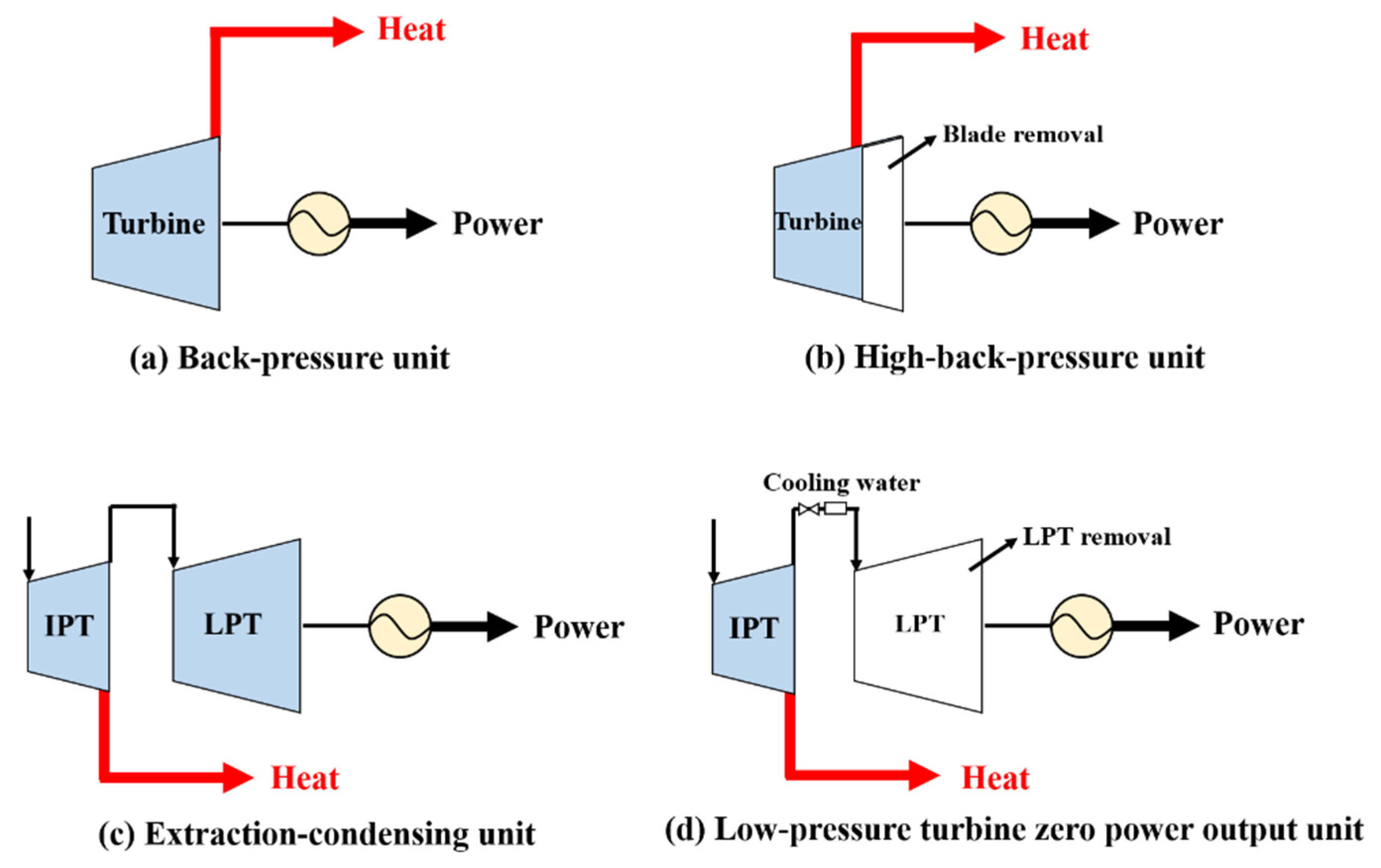
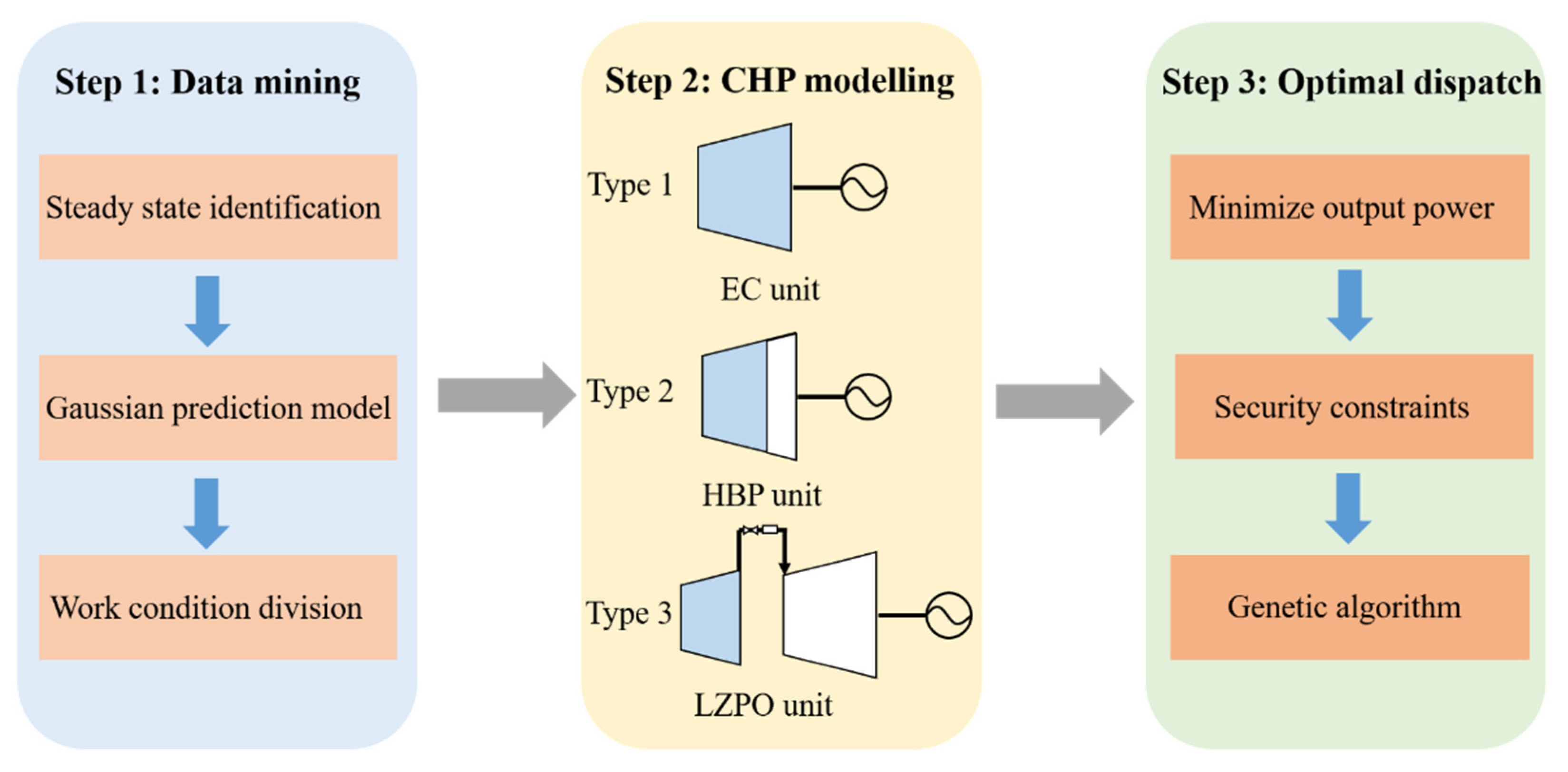
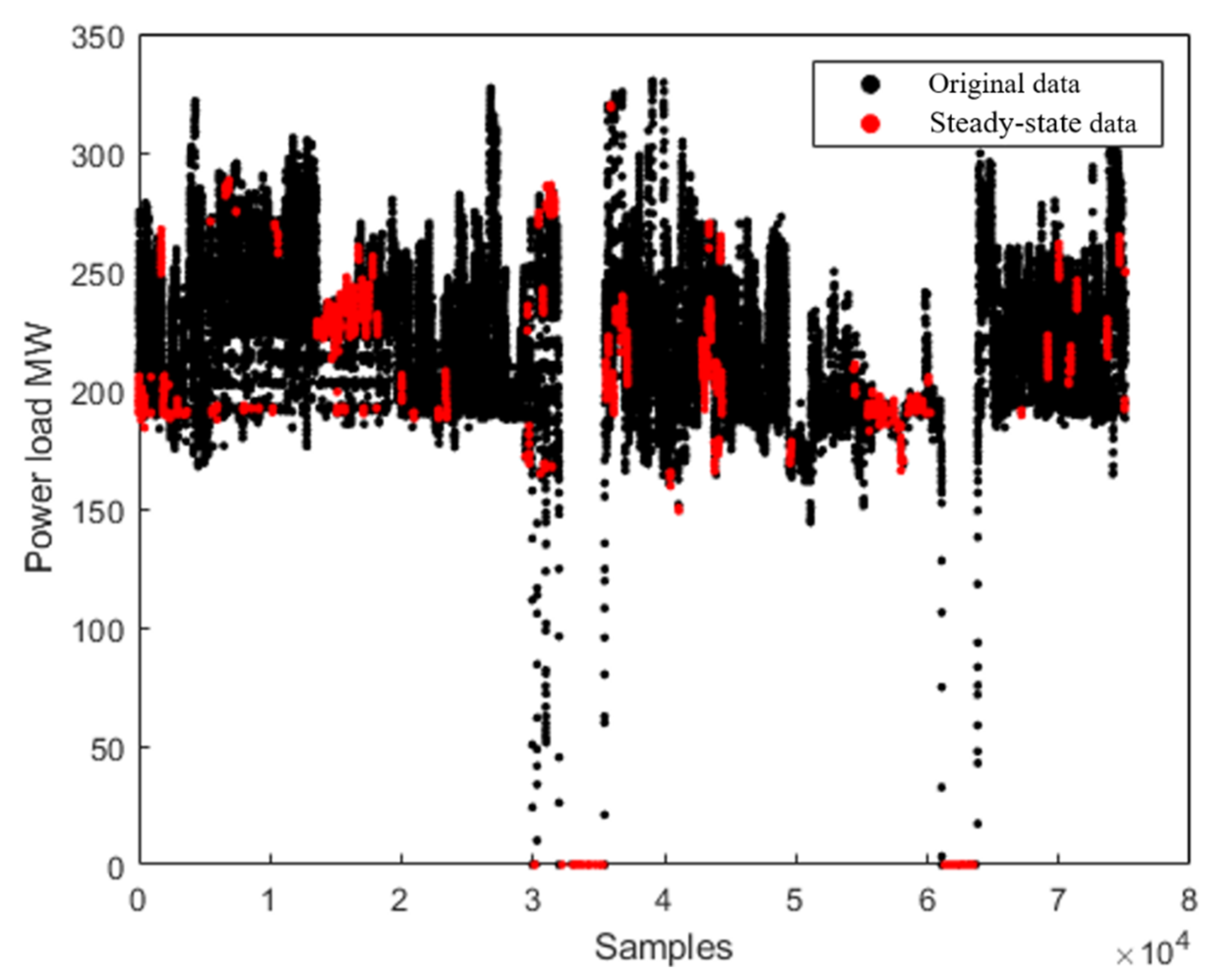

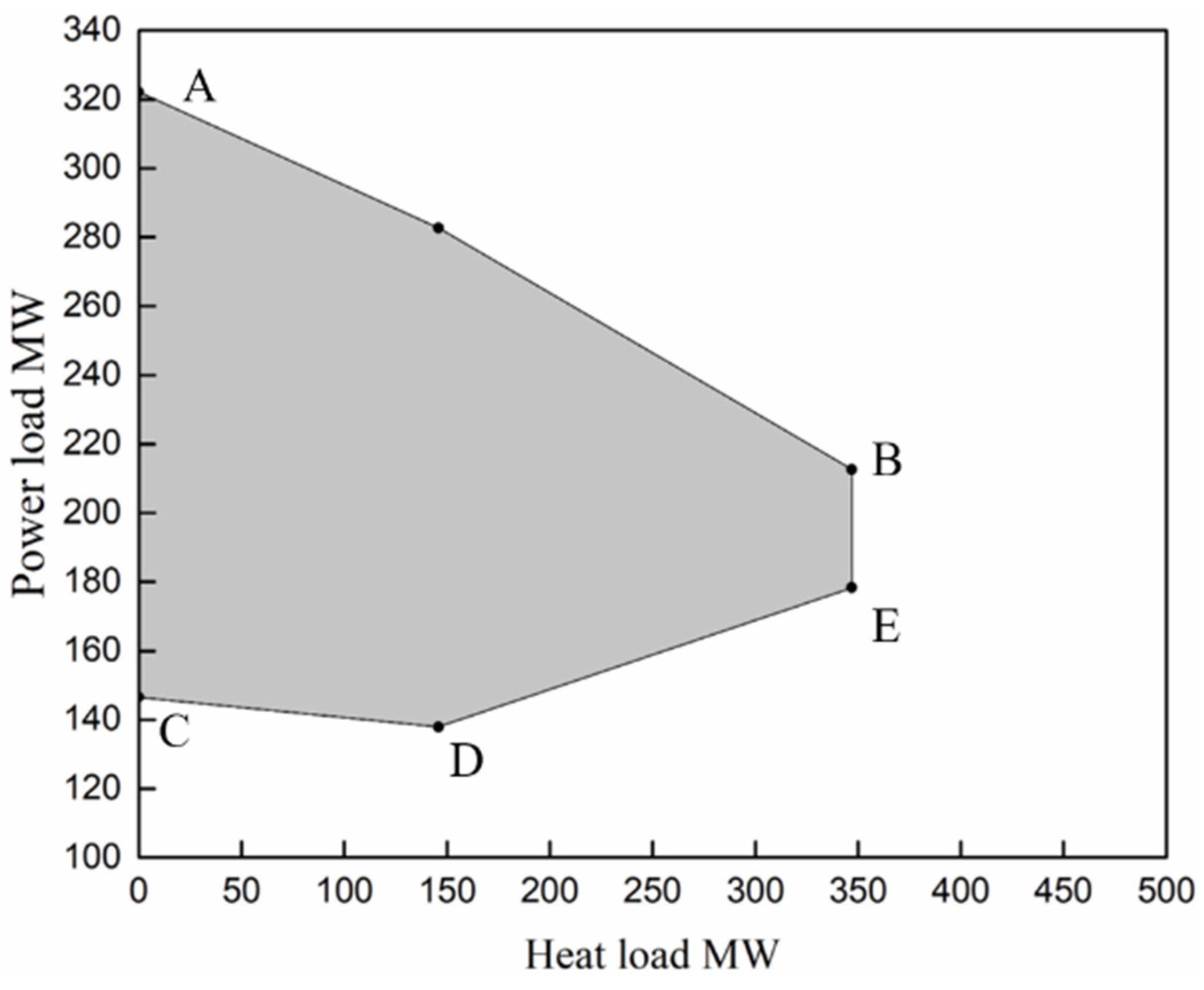

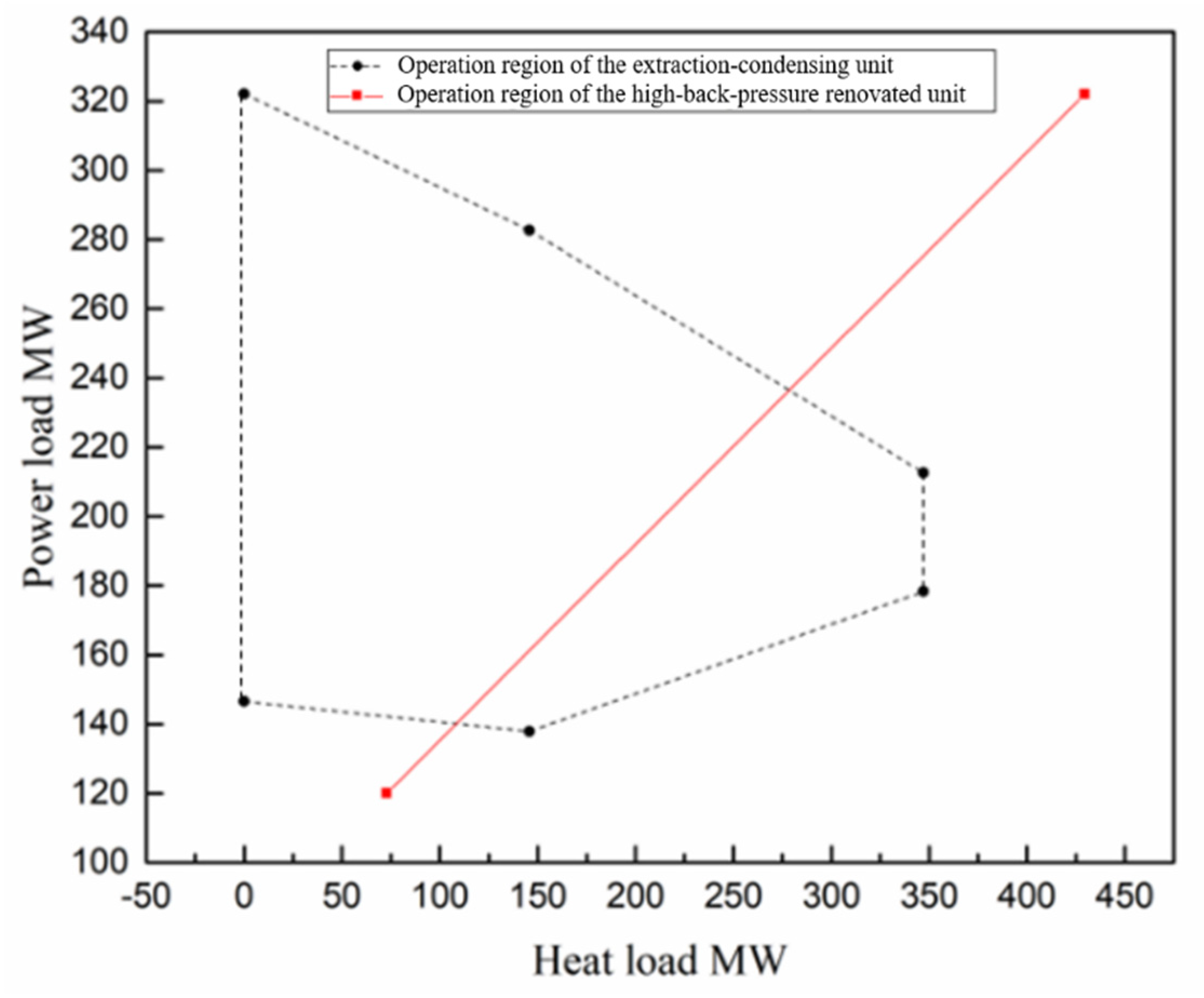
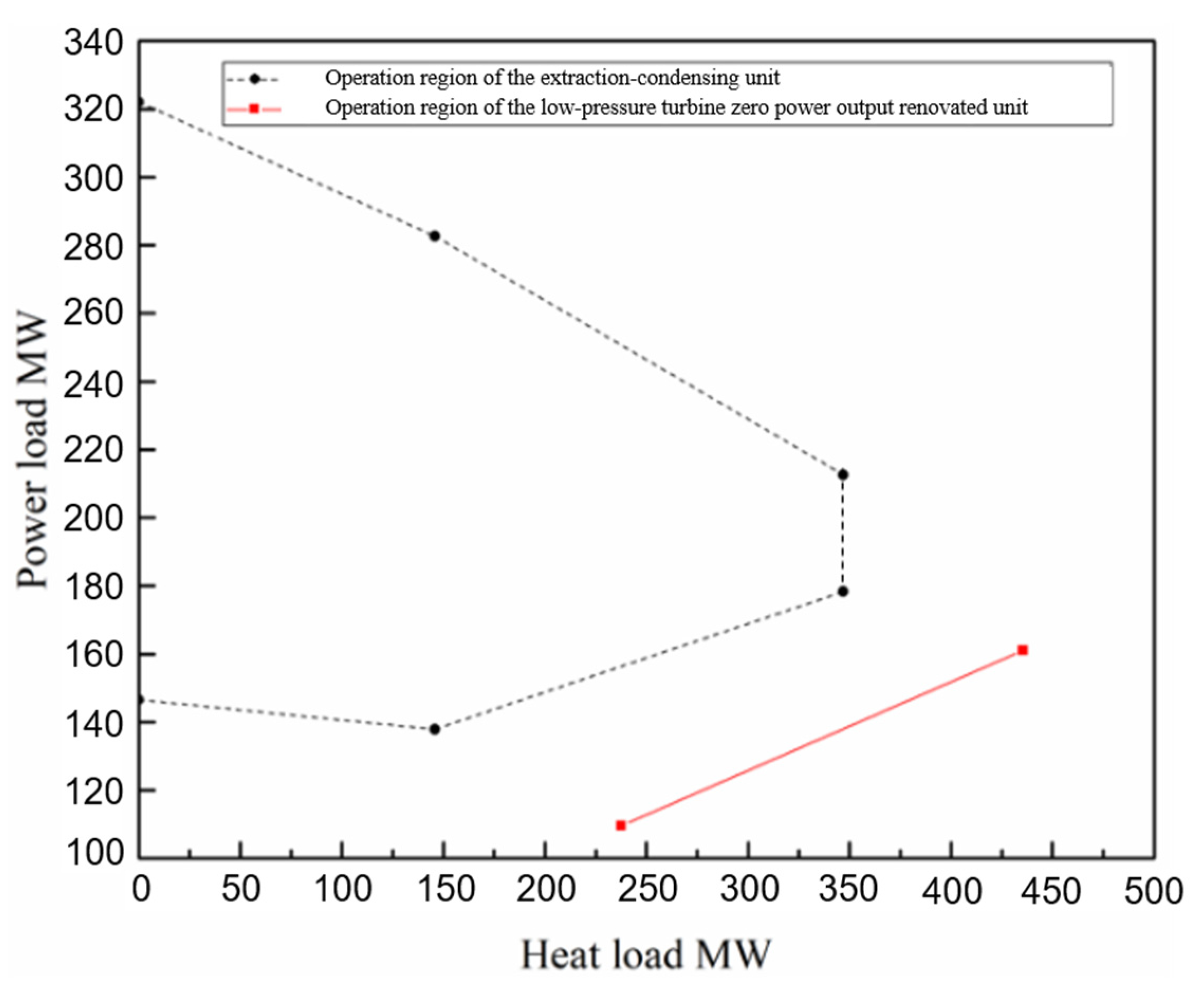
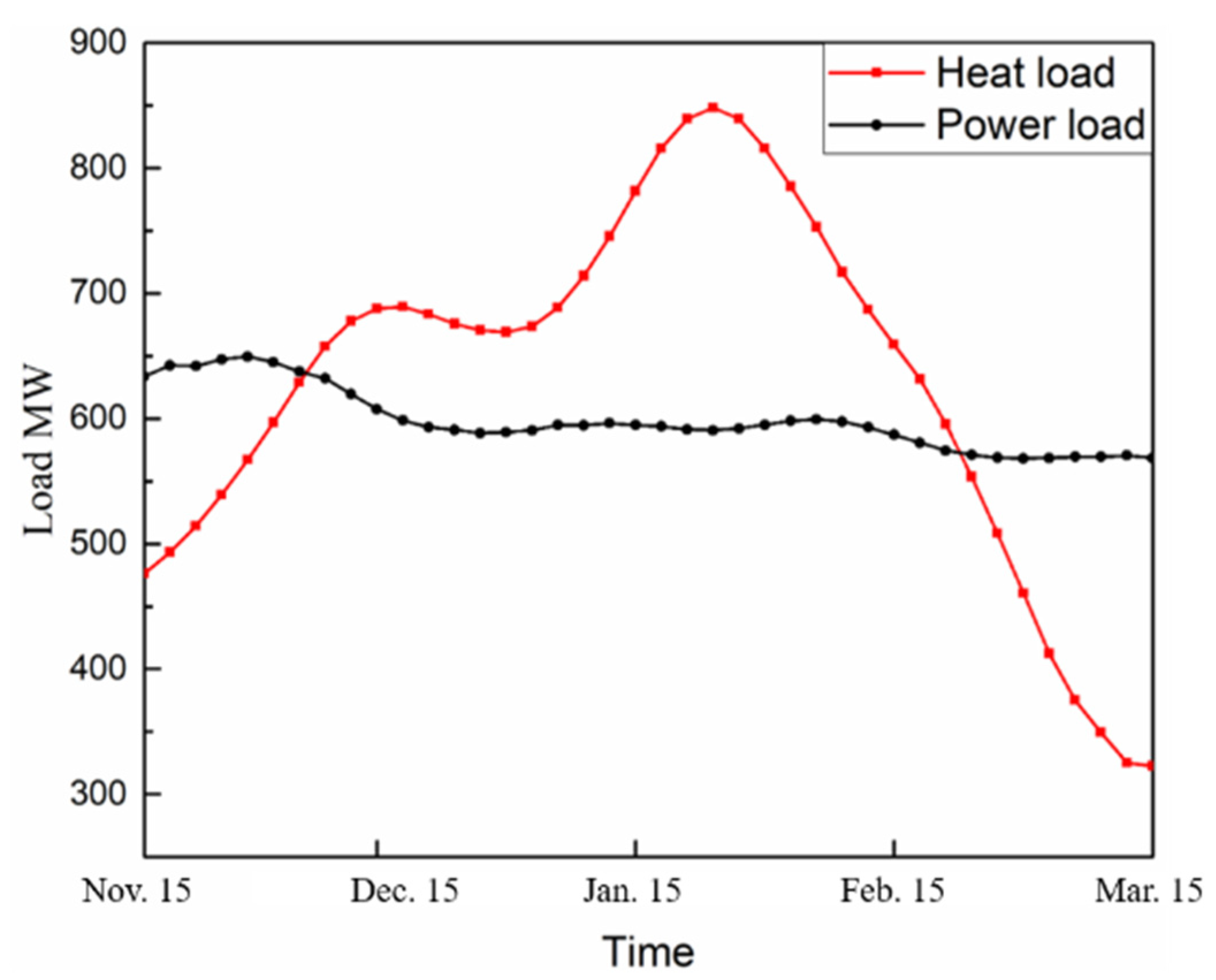
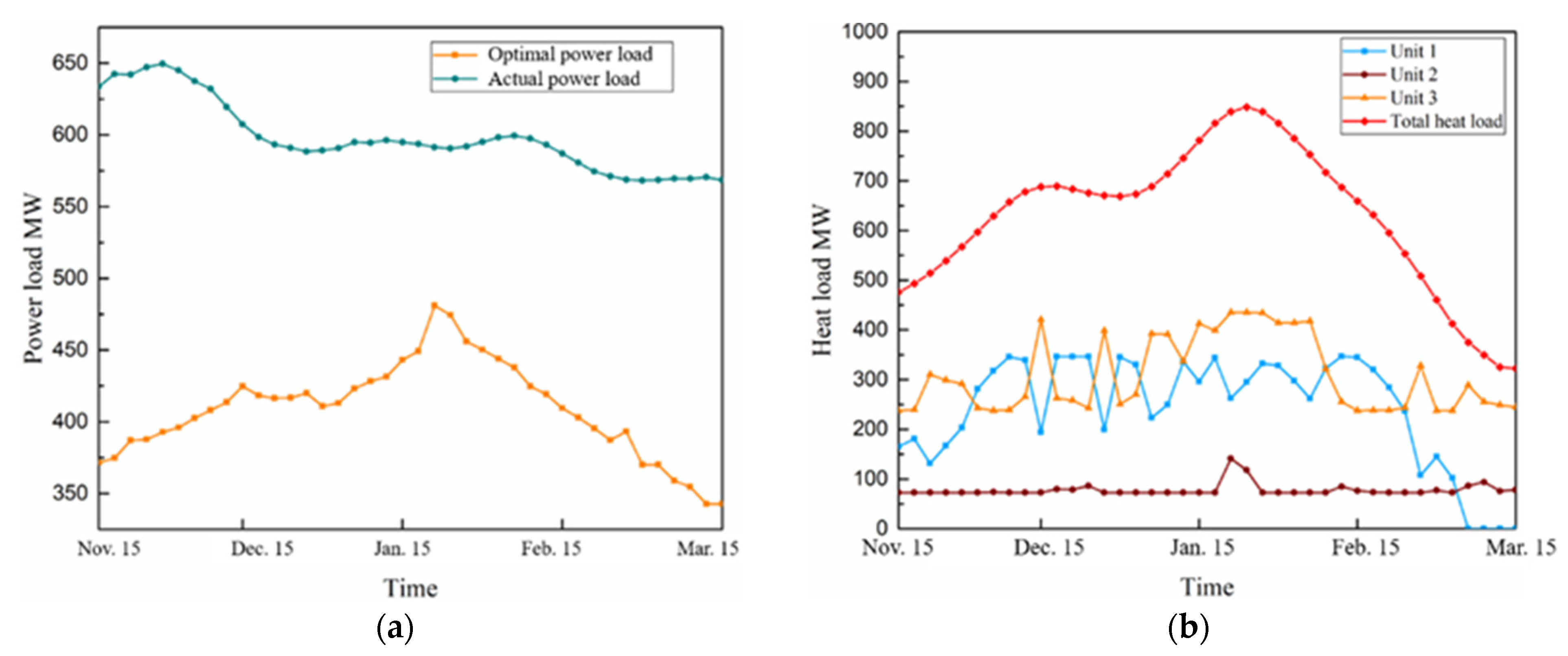
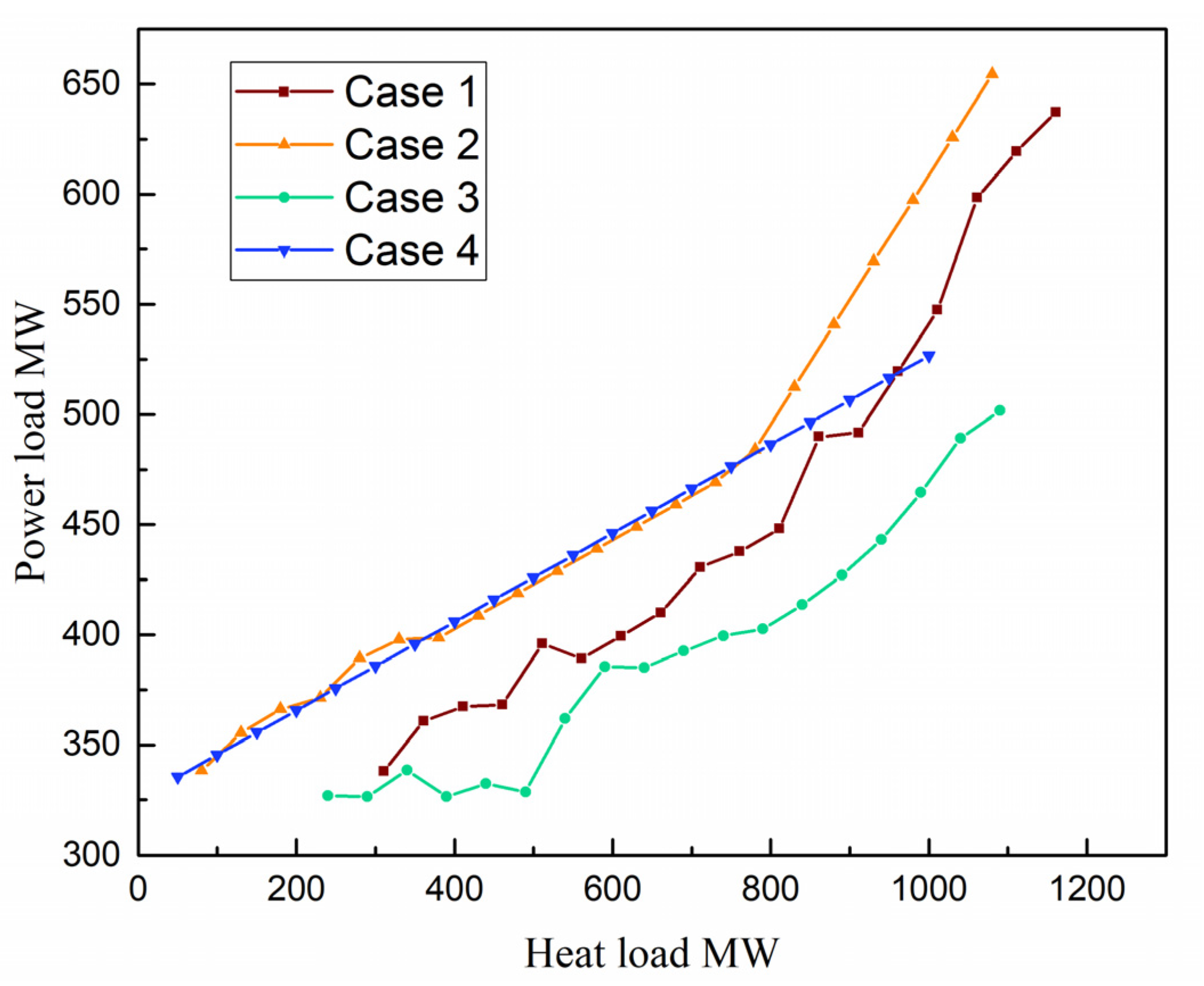
| Items | |
|---|---|
| Power load/MW | ±10% |
| Main steam pressure/MPa | ±2% |
| Main steam temperature/°C | ±10% |
| Reheat steam temperature/°C | ±10% |
| Extraction Condensing Type | Back Pressure Type |
|---|---|
| Feedwater flow rate/th−1 | Feedwater flow rate/th−1 |
| Main steam pressure/MPa | Main steam pressure/MPa |
| Main steam temperature/°C | Main steam temperature/°C |
| Heating extraction steam flow rate/th−1 | Condensing water flow rate/th−1 |
| Heating extraction steam temperature/°C | Condensing water inlet temperature/°C |
| Heating extraction steam pressure/MPa | Condensing water exit temperature/°C/MPa |
| Items | Value |
|---|---|
| Number of iterations | 200 |
| Number of population size | 40 |
| Crossover probability | 0.5 |
| mutation probability | 0.15 |
| Items | #1 Unit | #2 Unit | #3 Units |
|---|---|---|---|
| Case 1 | EC | HBP renovation | LZPO renovation |
| Case 2 | EC | HBP renovation | EC |
| Case 3 | EC | EC | LZPO renovation |
| Case 4 | EC | EC | EC |
Publisher’s Note: MDPI stays neutral with regard to jurisdictional claims in published maps and institutional affiliations. |
© 2022 by the authors. Licensee MDPI, Basel, Switzerland. This article is an open access article distributed under the terms and conditions of the Creative Commons Attribution (CC BY) license (https://creativecommons.org/licenses/by/4.0/).
Share and Cite
Zhu, L.; Lin, C.; Wang, C.; Song, J. Optimal Dispatch of Multi-Type CHP Units Integrated with Flexibility Renovations for Renewable Energy Accommodation. Energies 2022, 15, 7166. https://doi.org/10.3390/en15197166
Zhu L, Lin C, Wang C, Song J. Optimal Dispatch of Multi-Type CHP Units Integrated with Flexibility Renovations for Renewable Energy Accommodation. Energies. 2022; 15(19):7166. https://doi.org/10.3390/en15197166
Chicago/Turabian StyleZhu, Lingkai, Chengkun Lin, Congyu Wang, and Jiwei Song. 2022. "Optimal Dispatch of Multi-Type CHP Units Integrated with Flexibility Renovations for Renewable Energy Accommodation" Energies 15, no. 19: 7166. https://doi.org/10.3390/en15197166





